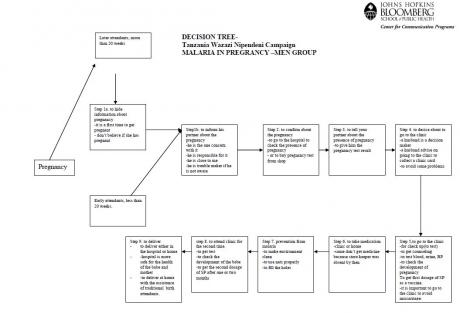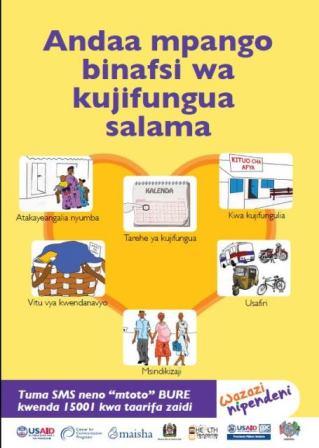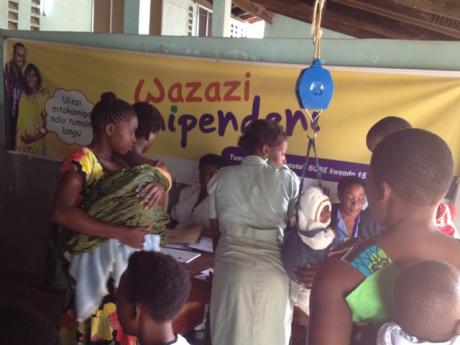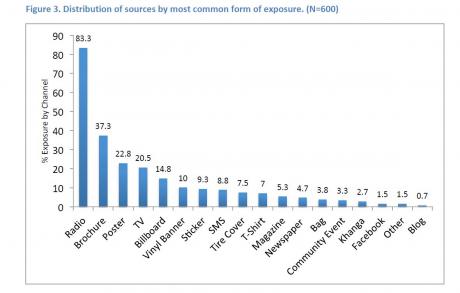Wazazi Nipendeni (Love Me, Parents) is a national safe motherhood social and behavior change communication (SBCC) campaign. Phase I of the campaign launched in 2012 to encourage Tanzanian women and their partners to take steps for a healthy pregnancy and safe delivery. It was designed and managed in coordination with the Tanzania Capacity and Communication Project (TCCP).
The ultimate goal of Phase I is to improve maternal and child health outcomes.
Originally conceived as a prevention of malaria in pregnancy campaign, the initiative was expanded to include several key safe motherhood behaviors, including early and complete antenatal care attendance, HIV testing, PMTCT enrollment, utilization of long-lasting insecticide-treated bed nets, uptake of sulfadoxine-pyrimethamine (SP) for the prevention of malaria in pregnancy, individual birth planning, and delivery at a health facility.
Phase II of the campaign launched in 2015 and expanded the scope of the campaign from pregnancy and delivery to include post-partum period care for newborns and up to a child’s first birthday. Phase II communication objectives focus on malaria, anaemia and tetanus prevention, life-long ART for HIV positive pregnant and lactating women, Vitamin A, post-natal care attendance, danger signs, early and exclusive breastfeeding, immunizations, and post-partum family planning.
Timeline
Inquire
The Tanzania team’s first step in the SBCC process was to review the latest national level data, policies, guidelines, strategies, and research, to consult stakeholders and form a campaign Task Force, and to conduct a decision-tree modeling exercise in order to inform the design of the campaign. The Task Force was led by the Ministry of Health and Social Welfare and included several implementing partners.
The 2010 Tanzania Demographic and Health Survey (TDHS) data showed that, although maternal, newborn and child health (MNCH) had seen improvements in Tanzania in the last few decades, Tanzanian women still faced an unacceptably high risk of preventable morbidity and mortality during their reproductive years. The TDHS also revealed that antenatal care (ANC) attendance was often late and incomplete. While 96% of women attended ANC at least once, only 15% received their first ANC visit during their first trimester, and less than half (43%) received the recommended number of four or more ANC visits. Furthermore, only 50% of births occurred in a health facility, and 51% were assisted by a skilled provider. In addition, only about 70% of pregnant women are reportedly reached with prevention of mother to child transmission (PMTCT) interventions. An estimated 1.6 million pregnant women in the country contract malaria annually, and the disease is a contributing factor to both maternal deaths and infant morbidity and mortality.
The campaign Task Force’s stakeholder review of barriers to healthy pregnancy practices revealed a culture of secrecy around pregnancy in Tanzania, and a fear that any interference with God’s plan will cast an evil eye on the unborn baby and the mother, which often resulted in late disclosure of pregnancy to health providers and birth supporters. In addition to the distance to health facilities and associated costs of leaving home or work, many women did not see the need to go the clinic or take medication if they were not sick, feared the side effects of SP, or felt that they’d be seen as “weak” if they delivered in a health facility, especially after having the first child.
The team also utilized decision-tree modeling in order to better understand household-level decision-making around net use, ANC attendance, and SP uptake.

Design your Strategy
The campaign’s problem statement was initially about malaria. Then, formative research showed that messages about safe motherhood were also critical in order to enhance the understanding of malaria prevention.
Love was seen as the driving factor and therefore became the focal point for the campaign’s design. While primarily aiming to reach pregnant women, the campaign also addressed messages to birth supporters (family and friends), women who were considering becoming pregnant soon, health providers, and community leaders.
During the strategy design process, the focus of the campaign shifted from that of malaria in pregnancy alone, to that of healthy pregnancy more comprehensively. Thus, while the objectives of the campaign originally centered around insecticide treated net (ITN) use and receipt of two or more doses of SP to prevent malaria in pregnancy, the messages were broadened to cover a wider range of issues.
The objectives of the campaign, therefore, were to increase the proportion of pregnant women who:
- Attend ANC within the first 16 weeks of pregnancy
- Attend ANC at least four times during pregnancy
- Sleep under a treated net every night
- Receive two or more doses of SP for the prevention of malaria in pregnancy
- Test for HIV together with their partner and receive the results
- Make an individual birth plan
- Deliver at a health facility with a skilled health provider
As part of the strategy development, the team worked to create the profile of a typical audience member. They called her Furaha. Furaha is a 24-year old class 7 drop-out who, in addition to taking care of her 10-month daughter, sells bananas to make some income. She is married to Tatizo, a 26-year old fisherman. They live in Furi village in the Lake Zone. Tatizo has been fishing since he was 15 and currently makes 2,000 Tanzanian Shillings (~$1.20) from this trade every day. Furaha recently discovered that she is 5 weeks pregnant. Since she delivered Riziki at home with a traditional birth attendant without any problems, she is planning to deliver at home again. She has not told anyone about her pregnancy because it is bad luck.

The typical audience member, “Furaha.” She is 24 years old married, mother of one and five weeks pregnant.
NOTE: Image used for illustrative purposes only.
Photo Credit: A smiling woman in Stone Town, Zanzibar, Tanzania. © 2010 Arturo Sanabria, Courtesy of Photoshare
Create and Test
With formative research results in hand, the campaign design team was formed to review the findings and oversee the campaign design process. The first step was to jointly prepare and review the campaign creative brief, which outlined the campaign’s goal, objectives, target audience, messaging approach, communication channels, timeline, and key monitoring and evaluation indicators.
The campaign’s main messages were:
- Go for ANC as soon as you suspect you are pregnant. Tell someone you trust about your pregnancy early on so they can support you.
- It is possible to have a healthy baby even if you are HIV positive.
- Getting two doses of SP and sleeping under your treated net every night will help prevent malaria in pregnancy.
- Discuss and decide with your partner and birth supporters your due date, the health facility for delivery, your transportation plan, the supplies needed when you deliver, who will accompany you to the health facility, and who will take care of your home while you are away.
The team issued a Request for Proposals to several local advertising agencies to help design the campaign that was centered on love for the unborn baby and pregnant woman.
One of the most important campaign elements changed after stakeholder review and pre-testing. While the original campaign name was, “Love me, mama”, the Task Force drew attention to the importance of addressing both parents. After pre-testing options with the target audience, the name of the campaign shifted to, “Love me, parents”.

The campaign’s individual birth planning poster. “One of the biggest accomplishments of the campaign, in my eyes, has been the roll out of the standardized individual birth plan (IBP).” — Dr. Dunstan Bishanga, Director of MNCH Program, Jhpiego Tanzania
- Wazazi Nipendeni Campaign Materials
- Wazazi Nipendeni – Pregnancy Wheel
- Wazazi Nipendeni – Individual Birth Planning Antenatal Care Card
- Wazazi Nipendeni – Malaria Prevention During Pregnancy
- Wazazi Nipendeni – Individual Birth Planning
- Wazazi Nipendeni – Individual Birth Planning
- Wazazi Nipendeni (Love me, parents) Radio Jingle
- Wazazi Nipendeni – Malaria Prevention in Pregnancy Radio Spot 1
- Wazazi Nipendeni – Malaria Prevention in Pregnancy Radio Spot 2
- Wazazi Nipendeni Individual Birth Plan Radio Spot
- Wazazi Nipendeni – Delivery at a Health Facility Radio Spot
- Wazazi Nipendeni – Antenatal Care Radio Spot
- Wazazi Nipendeni – Prevention of Malaria in Pregnancy TV Spot
- Wazazi Nipendeni – PMTCT TV Spot
- Wazazi Nipendeni Birth Planning TV Spot]
- Wazazi Nipendeni – Safe Motherhood Banner
- Wazazi Nipendeni – Safe Motherhood Banner
- Wazazi Nipendeni Safe Motherhood Spare Tire Cover
- Wazazi Nipendeni [T-shirt]
- Wazazi Nipendeni (Love me, parents) [Sticker]
- Wazazi Nipendeni – Safe Motherhood Billboard
- Wazazi Nipendeni (Love me, parents) [Promotional Bag]
- Wazazi Nipendeni (Love me, parents) Campaign Creative Brief
- Wazazi Nipendeni Text Messaging
- Wazazi Nipendeni Report
Mobilize and Monitor
Wazazi Nipendeni was officially launched by the Minister of Health and Social Welfare at Nyamagana Stadium in Mwanza region on November 20, 2012. Partners came together to provide ANC and RMNCH services, disseminate healthy pregnancy and healthy baby information, and assist community members in registering for the SMS platform while local musicians, dance troupes and comedy groups provided safe motherhood-related entertainment.
The event was preceded by an orientation for the partners as well as a media orientation, during which radio DJs, presenters, and print and electronic journalists were oriented on the campaign objectives, messages, and materials, the SMS platform, and the media’s role in the campaign.
Distribution of print materials to Tanzania’s hospitals, health centers, and dispensaries took place prior to the campaign launch through the campaign’s service delivery partners. This took place in partnership with the regional and district health management teams, who delivered materials to health facilities during their monthly supportive supervision visits.
Radio and TV spots began airing on the same day as the launch. During the initial media blitz, the team ran 6-12 radio spots per station per day on 16 national and regional radio stations, and three spots per station per day on six TV stations. The initial, intensive campaign period continued through the end of December 2012, then entered a maintenance phase from January to March, 2013. After a three-month break, the campaign resumed broadcast from July 2013 – February 2014.
At the same time that the campaign team was developing the materials, the mHealth Tanzania Partnership was hard at work developing the Healthy Pregnancy, Healthy Baby (HPHB) Text Messaging Service. All radio spots, TV spots, print and outdoor materials encourage listeners and viewers to send a free text message to a dedicated short-message-service (SMS) number to receive more information on healthy pregnancy. A set of initial introductory questions allows users to register as pregnant women, mothers of newborns, birth supporters, or general information seekers, and establish the date of pregnancy or age of the newborn, where relevant. Users then receive information, tips, and reminders timed to the week/month of pregnancy or age of the baby. Subscribers receive an average 3-4 messages/week across a number of safe motherhood topic areas. The service is free of charge for users across all mobile networks.
The first Wazazi Nipdendeni survey, fielded in December 2012 – just two weeks after the campaign first went on air – revealed that 22% of respondents had already been exposed to the campaign. Omnibus surveys conducted again in March 2013, June 2013, October 2013, and April 2014 and showed that anywhere from 33%-46% of respondents had seen or heard the campaign. Radio was consistently the most frequently cited source of campaign exposure.

Pregnant women and their partners enroll in the Wazazi Nipendeni SMS service during the campaign launch in Mwanza. “The Wazazi Nipendeni multi-media campaign has played a great role in promoting the Healthy Pregnancy Healthy Baby text messaging service to the community.” – Mutasingwa Saulo, CDC Foundation, mHealth Tanzania Partnership Project Leader for the Healthy Pregnancy, Healthy Baby Text Messaging Service (HPHB)
Evaluate and Evolve
An impact evaluation was conducted in October 2013, ten months after campaign launch. Exit interviews were conducted with 1,708 ANC/PNC clients, and an observation checklist was used to determine if campaign materials were available in 122 health facilities in five regions.
Key findings from the evaluation include:
Campaign Reach and Recall
- Over a third of surveyed women (35.1%) were exposed to the campaign, with 16.5% reporting daily exposure.
- The primary source of exposure was radio (83.3%), which also provided the highest frequency of exposure.
- Almost a third of those exposed to the campaign recalled multiple messages.
- Only 7.1% of 1,708 women reported hearing anything about the SMS system. Of the 36 women who texted, 30 (83.3%) completed the SMS registration process.
Availability of Campaign Materials
- Twenty percent (20%) of health facilities had all five campaign materials, 70% had some (1-4), and 10% had none.
- The pregnancy wheel was most widely available (82.0%), followed by the SP reminder cards (67.2%) and Individual Birth Planning (IBP) brochures (57.3%). SP and IBP posters were available in 39.3% of the facilities visited.
Impact
- Exposure to the campaign was a significant predictor of number of ANC visits, HIV testing, individual birth planning, delivery at a health facility, knowledge of malaria in pregnancy, receipt of SP, number of doses of SP received, and net use.
- Campaign exposure was not a significant predictor of timing of the first ANC visit or partner testing for HIV.

Wazazi Nipendeni Evaluation Report 2014: Graph #1: Exposure to the campaign (M/F, Rural/Urban) Graph #2: Distribution of sources by most common form of exposure. (N=600)
Planning for the Future
Key recommendations for future programming include:
- Establish mechanisms to ensure campaign materials reach their final intended destination, and that providers are appropriately oriented on their use.
- Institute a system to capture health facility data from partners before, during, and after the campaign in order to determine if campaign implementation is associated with an increase in uptake of services and intended health outcomes.
- Utilize existing community outreach structures to strengthen community engagement in the campaign.
- Enhance promotion of the SMS platform by giving it its own dedicated radio/TV spots and print/promotional materials,
- Broadcast the campaign on local and regional radio stations in addition to national stations in order to increase rural reach.
- Include messaging encouraging women to move closer to the health facility as their due date approaches.
Partnerships
Wazazi Nipendeni is a partnership led by the Ministry of Health and Social Welfare Reproductive and Child Health Section in coordination with the National Malaria Control Program (NMCP), the National AIDS Control Program (NACP), the Health Promotion and Education Section, and the mHealth Tanzania Public Private Partnership. The campaign is funded by the United States Government through the US Agency for International Development (USAID), the US President’s Malaria Initiative (PMI), the US President’s Emergency Plan for AIDS Relief (PEPFAR), and the Centers for Disease Control and Prevention (CDC).
The campaign was developed by the Johns Hopkins Bloomberg School of Public Health Center for Communication Programs (JHU∙CCP) and the SMS component by the mHealth Tanzania Public Private Partnership. Partners include Jhpiego, Elizabeth Glaser Pediatric AIDS Foundation (EGPAF), Mwanzo Bora program, FHI360, Catholic Relief Services (CRS), CCBRT, Deloitte – Tunajali project, PLAN International, Aga Khan Health Services, and a number of projects on the ground.
Phase II!
Phase II of Wazazi Nipendeni launched in July 2015.
Objectives
In Phase II, Wazazi Nipendeni expands its scope from pregnancy and delivery to include post-partum period care for newborns and up to a child’s first birthday. New communication objectives focus on malaria, anaemia and tetanus prevention, life-long ART for HIV positive pregnant and lactating women, Vitamin A, post-natal care attendance, danger signs, early and exclusive breastfeeding, immunizations, and post-partum family planning.
Launch
A press conference and media orientation was followed by two days of demand creation, service provision, and entertainment-education at Mwembeyanga Grounds in Temeke, Dar es Salaam. Service delivery partners provided family planning services, VCT, malaria testing, net repair, and breast and cervical cancer screening, while stage performances by local musicians helped to draw huge crowds. An estimated 5,000 people attended launch.

Activities
Fifteen radio spots and four television spots demonstrated how couples around Tanzania “showed their love” in the new Phase II health areas. Refreshed promotional items such as bumper stickers, banners, t-shirts and khangas promoted the Wazazi Nipendeni brand. The mHealth PPP expanded the Wazazi Nipendeni Text Messaging Service to include Phase II’s new content. In Phase II, users with incomplete subscriptions were automatically enrolled as General Information Seekers.
To give the campaign a “fresh” look and feel, while having a clear connection to Phase I, the campaign slogan, “Onyesho upendo wako” (“Show your love”), was included along with a heart as a key design element. While Phase I emphasized the yellow of the color scheme, Phase II brought out the purple.

Results
By the end of March 2016:
- A total of 1,305,606 people had registered since the start of the campaign
- Over 86 million text messages had been sent to users
- The overwhelming majority of users (96.3%) self-enrolled, while 3.7% were assisted enrollments
- The November 2015 omnibus report found that 35.4% of respondents reported exposure to Wazazi Nipendeni. This increased to 54.5% in March 2016.
- Through collaboration with MoH and partners at the launch, 1,061 individuals tested for HIV, 316 tested for malaria, 329 people received family planning services, 46 women were screened for cervical cancer, and 93 women were screened for breast cancer
Banner photo: Having just given birth the day before, Violet Ziratsi waits with other mothers to see a midwife for vaccinations and health education tips at the postnatal clinic at Gonja Lutheran Hospital in the Pare Mountains of Northern Tanzania. © 2012 FELM/organization, Courtesy of Photoshare.
Date of Publication: April 20, 2022


